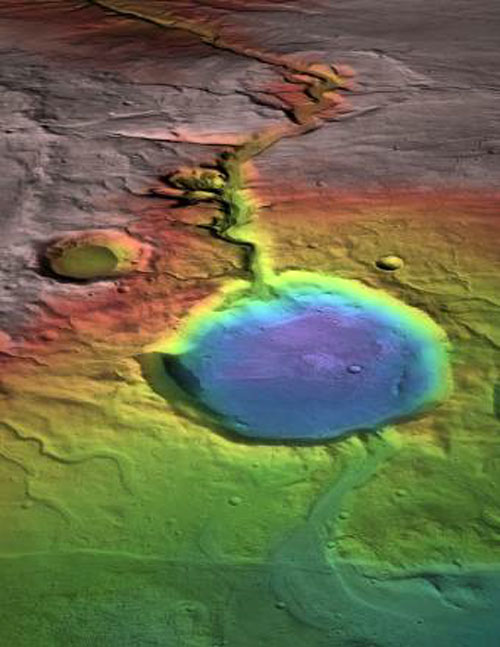.

Warmth and flowing water?
Although the surface is now cold and desiccated, in early Mars history water formed an open-basin lake, filling the crater, forming a delta, and breaching the lower rim as water flowed to lower elevations (blue).
NASA/Mars Reconnaissance Orbiter Rendering by James Dickson, Brown University
.
How to reconcile indisputable evidence of flowing water on Mars with severely low temperatures? New research shows volcanism and greenhouse gas could have warmed the planet sufficiently, but only for tens or hundreds of years at a time.
PROVIDENCE, R.I. [Brown University] — Ample evidence of ancient rivers, streams, and lakes make it clear that Mars was at some point warm enough for liquid water to flow on its surface. While that may conjure up images of a tropical Martian paradise, new research published in Nature Geoscience throws a bit of cold water on that notion.
The study, by scientists from Brown University and Israel’s Weizmann Institute of Science, suggests that warmth and water flow on ancient Mars were probably episodic, related to brief periods of volcanic activity that spewed tons of greenhouse-inducing sulfur dioxide gas into the atmosphere. The work, which combines the effect of volcanism with the latest climate models of early Mars, suggests that periods of temperatures warm enough for water to flow likely lasted for only tens or hundreds of years at a time.
With all that’s been learned about Mars in recent years, the mystery of the planet’s ancient water has deepened in some respects. The latest generation of climate models for early Mars suggests an atmosphere too thin to heat the planet enough for water to flow. The sun was also much dimmer billions of years ago than it is today, further complicating the picture of a warmer early Mars.
“These new climate models that predict a cold and ice-covered world have been difficult to reconcile with the abundant evidence that water flowed across the surface to form streams and lakes,” said James W. Head, professor of earth, environmental and planetary sciences at Brown University and co-author of the new paper with Weizmann’s Itay Halevy. “This new analysis provides a mechanism for episodic periods of heating and melting of snow and ice that could have each lasted decades to centuries.”
Halevy and Head explored the idea that heating may have been linked to periodic volcanism. Many of the geological features that suggest water flow date to around 3.7 billion years ago, a time when massive volcanoes are thought to have been active and huge lava outpourings occurred. On Earth, however, widespread volcanism often leads to cooling rather than warming. Sulfuric acid particles and thick ash reflect the sun’s rays, and that can lower temperatures. But Head and Halevy thought the effects of sulfur in Mars’ dusty atmosphere might have been different.
To find out, the researchers created a model of how sulfuric acid might react with the widespread dust in the Martian atmosphere. The work suggests that those sulfuric acid particles would have glommed onto dust particles, which would reduce their ability to reflect the sun’s rays. Meanwhile sulfur dioxide gas would produce a modest greenhouse effect — just enough to warm the Martian equatorial region so that water could flow.
Head has been doing fieldwork for years in Antarctica and thinks the climate on early Mars may have been very similar to that of the cold, desert-like McMurdo Dry Valleys.
“The average yearly temperature in the Antarctic Dry Valleys is way below freezing, but peak summer daytime temperatures can exceed the melting point of water, forming transient streams, which then refreeze,” Head said. “In a similar manner, we find that volcanism can bring the temperature on early Mars above the melting point for decades to centuries, causing episodic periods of stream and lake formation.”
But as that early active volcanism on Mars ceased, so did the possibility of warmer temperatures and flowing water.
Head said the research may offer new clues about where the fossilized remnants of life might be found on Mars, if it ever existed.
“Life in Antarctica, in the form of algal mats, is very resistant to extremely cold and dry conditions and simply waits for the episodic infusion of water to ‘bloom’ and develop,” he said. “Thus, the ancient and currently dry and barren river and lake floors on Mars may harbor the remnants of similar primitive life, if it ever occurred on Mars.”
Quelle: Brown University
4098 Views

